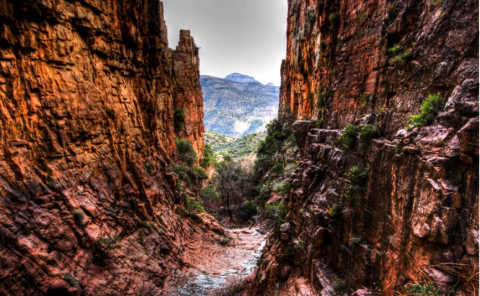The Geology of Tonto National Monument: Stories Only Rocks Can Tell
Aug 02,2015
As I drove along the curvaceous dirt road that led me through the Sierra Anchas of Arizona, my eyes and soul were captured by the glowing of orange cliffs that overshadowed the region's dark canopy of pinyin pines. These orange walls of rock, filled with the white cream of limestone, have ridden astride my car since before my arrival in the Tonto Basin and have guided me through the rocky pathways that shape the region of the American southwest. Giant red boulders perched on thrones of high desert mesas and watched over me as my car wove it's way through the mountains. These rocks have stood watching over the land like gods and hold some of the world's oldest memories. Somewhere beneath their outer wall of silence lies the key to unlocking the secrets of Earth's past.
According to the National Park Service, the Tonto Basin lies within central highland transition zone; one of the most rugged sections of terrain in the state of Arizona. The oldest rocks found within this zone make up the Apache group and formed 1.6 billion years ago due to ocean sedimentation. The cave that houses the lower cliff dwelling at Tonto National Monument is part of this group and consists of basalt, limestone, quartzite, and the Gila conglomerate.
Inside, deposits of quartzite broke apart from the walls of the cave, and covered the floor in hundreds of usable bricks. So, when the Salado culture entered the region in 1250 CE, the caves welcomed them home with shelter and a fresh pile of building supplies for them to construct the dwellings we see today. From the quartzite also came composites of shale, siltstone, and sandstone. Siltstone chips away easily from the cave's walls and has revealed a colorful underbelly of hematite and limonite which the Salado used to created their red and white paints-a valuable trade good among the people. Other mineral resources that proved to be valuable trade sources in the Tonto Basin included obsidian, turquoise, malachite, and azurite.
Before I entered the Tonto Basin, I never thought of rocks as living creatures with a life. But now I realize that like all living things, they are born, shaped by tension and pressure, and erode. Out here these rainbow rocks are more than just rubble; they are keystones.
Sources:
National Park Service. “Environmental Consequences: Natural Resources-Topography, geology, and Soils” Final Environmental Impact Statement General Management Plan. Roosevelt, AZ. (2003).
McAuliffe, J.R. “Desert Soils” A Natural History of the Sonoran Desert. Edited by Steven J. Phillips and Patricia Wentworth Comus. Arizona-Sonoran Desert Museum Press. Tucson, AZ. © Arizona-Sonoran Desert Museum (2000).
Photo credit: Ron Pelton Jr.






